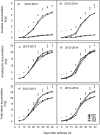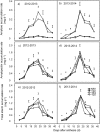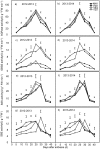Grain Yield, Starch Content and Activities of Key Enzymes of Waxy and Non-waxy Wheat (Triticum aestivum L.)
- PMID: 29540822
- PMCID: PMC5852034
- DOI: 10.1038/s41598-018-22587-0
Grain Yield, Starch Content and Activities of Key Enzymes of Waxy and Non-waxy Wheat (Triticum aestivum L.)
Erratum in
-
Author Correction: Grain Yield, Starch Content and Activities of Key Enzymes of Waxy and Non-waxy Wheat (Triticum aestivum L.).Sci Rep. 2018 May 1;8(1):7090. doi: 10.1038/s41598-018-25219-9. Sci Rep. 2018. PMID: 29712971 Free PMC article.
Abstract
Waxy wheat has unique end-use properties; however, its production is limited due mainly to its low grain yield compared with non-waxy wheat. In order to increase its grain yield, it is critical to understand the eco-physiological differences in grain filling between the waxy and non-waxy wheat. In this study, two waxy wheat and two non-waxy wheat cultivars were used to investigate the differences in starch-associated enzymes processes, sucrose and starch dynamics, yield components, and the final grain yield. The results indicated that the mean total grain starch and amylose content, the average 1000-kernel weight and grain yield of the waxy wheat were lower than those of the non-waxy wheat at maturity. The amylose content was significantly and positively correlated with the activity of GBSS (r = 0.80, p < 0.01). Significant positive correlation also exists among activities of AGPase, SSS, GBSS, and SBE, except for GBSS-SBE. In summary, our study has revealed that the reduced conversion of sucrose to starch in the late grain filling stage is the main cause for the low kernel weight and total starch accumulation of the waxy wheat. The reduced conversion also appears to be a factor contributing to the lower grain yield of the waxy wheat.
Conflict of interest statement
The authors declare no competing interests.
Figures








Similar articles
-
Biosynthesis and Regulation of Wheat Amylose and Amylopectin from Proteomic and Phosphoproteomic Characterization of Granule-binding Proteins.Sci Rep. 2016 Sep 8;6:33111. doi: 10.1038/srep33111. Sci Rep. 2016. PMID: 27604546 Free PMC article.
-
Effect of high temperature on grain filling period, yield, amylose content and activity of starch biosynthesis enzymes in endosperm of basmati rice.J Sci Food Agric. 2015 Aug 30;95(11):2237-43. doi: 10.1002/jsfa.6941. Epub 2014 Oct 31. J Sci Food Agric. 2015. PMID: 25284759
-
Transcriptional coordination and abscisic acid mediated regulation of sucrose transport and sucrose-to-starch metabolism related genes during grain filling in wheat (Triticum aestivum L.).Plant Sci. 2015 Nov;240:143-60. doi: 10.1016/j.plantsci.2015.09.010. Epub 2015 Sep 10. Plant Sci. 2015. PMID: 26475195
-
Posttranslational Modification of Waxy to Genetically Improve Starch Quality in Rice Grain.Int J Mol Sci. 2021 May 3;22(9):4845. doi: 10.3390/ijms22094845. Int J Mol Sci. 2021. PMID: 34063649 Free PMC article. Review.
-
Molecular insights on the origin and development of waxy genotypes in major crop plants.Brief Funct Genomics. 2024 May 15;23(3):193-213. doi: 10.1093/bfgp/elad035. Brief Funct Genomics. 2024. PMID: 38751352 Review.
Cited by
-
Screening of Induced Mutants Led to the Identification of Starch Biosynthetic Genes Associated with Improved Resistant Starch in Wheat.Int J Mol Sci. 2022 Sep 15;23(18):10741. doi: 10.3390/ijms231810741. Int J Mol Sci. 2022. PMID: 36142653 Free PMC article.
-
Effect of Foliar Application of Various Nitrogen Forms on Starch Accumulation and Grain Filling of Wheat (Triticum aestivum L.) Under Drought Stress.Front Plant Sci. 2021 Mar 25;12:645379. doi: 10.3389/fpls.2021.645379. eCollection 2021. Front Plant Sci. 2021. PMID: 33841473 Free PMC article.
-
The Effects of Short-Term Exposure to Low Temperatures During the Booting Stage on Starch Synthesis and Yields in Wheat Grain.Front Plant Sci. 2021 Jul 9;12:684784. doi: 10.3389/fpls.2021.684784. eCollection 2021. Front Plant Sci. 2021. PMID: 34305982 Free PMC article.
-
Digital Absolute Gene Expression Analysis of Essential Starch-Related Genes in a Radiation Developed Amaranthus cruentus L. Variety in Comparison with Real-Time PCR.Plants (Basel). 2020 Jul 30;9(8):966. doi: 10.3390/plants9080966. Plants (Basel). 2020. PMID: 32751665 Free PMC article.
-
Partial substitution of organic nitrogen with synthetic nitrogen enhances rice yield, grain starch metabolism and related genes expression under the dual cropping system.Saudi J Biol Sci. 2021 Feb;28(2):1283-1296. doi: 10.1016/j.sjbs.2020.11.039. Epub 2020 Nov 17. Saudi J Biol Sci. 2021. PMID: 33613058 Free PMC article.
References
-
- Yoo S-H, Jane J-l. Structural and Physical Characteristics of Waxy and Other Wheat Starches. Carbohydrate Polymers. 2002;49:297–305. doi: 10.1016/S0144-8617(01)00338-1. - DOI
Publication types
MeSH terms
Substances
LinkOut - more resources
Full Text Sources
Other Literature Sources

